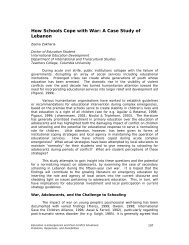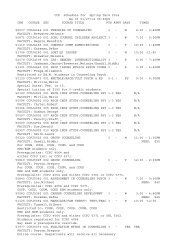The Comparative Fallacy in SLA Literature - Teachers College ...
The Comparative Fallacy in SLA Literature - Teachers College ...
The Comparative Fallacy in SLA Literature - Teachers College ...
Create successful ePaper yourself
Turn your PDF publications into a flip-book with our unique Google optimized e-Paper software.
<strong>Teachers</strong> <strong>College</strong>, Columbia University Work<strong>in</strong>g Papers <strong>in</strong> TESOL & Applied L<strong>in</strong>guistics, Vol. 4, No. 1<br />
<strong>The</strong> Forum<br />
the explicit hypothesis rejection group, which received the most explicit feedback, performed<br />
considerably better than the other feedback groups.<br />
Tomasello & Herron (1988)<br />
This study aimed to explore the relative effects of two methods for teach<strong>in</strong>g exceptions to<br />
grammatical rules: correction of <strong>in</strong>duced errors <strong>in</strong> Garden Path sentences, and explicit teach<strong>in</strong>g<br />
of exceptions to grammatical rules. Thirty-n<strong>in</strong>e college students enrolled <strong>in</strong> two sections of<br />
beg<strong>in</strong>n<strong>in</strong>g-level French classes participated. <strong>The</strong>y were randomly assigned to two groups. Each<br />
group received one teach<strong>in</strong>g method (Garden Path or explicit teach<strong>in</strong>g) for one semester, and<br />
then received the other teach<strong>in</strong>g method the follow<strong>in</strong>g semester. Eight target structures known as<br />
“exceptions to a rule” were randomly assigned to the two teach<strong>in</strong>g conditions. <strong>The</strong> students <strong>in</strong><br />
the Garden Path group received canonical exemplars and were encouraged to <strong>in</strong>duce the rule.<br />
After that, the students were presented with the exceptions to the rule, without be<strong>in</strong>g told that<br />
these were exceptions. In this process, the students were <strong>in</strong>duced to make errors, and the<br />
teachers immediately corrected the result<strong>in</strong>g overgeneralization errors. In the explicit rule<br />
presentation group, the students were explicitly taught the exception as an exception and<br />
expected to memorize the rules. <strong>The</strong> results of posttests <strong>in</strong>dicated that the students learned the<br />
exceptions better <strong>in</strong> the Garden Path condition, and such learn<strong>in</strong>g was ma<strong>in</strong>ta<strong>in</strong>ed throughout the<br />
semester. <strong>The</strong> study revealed the positive impact of feedback on learn<strong>in</strong>g exceptions by prov<strong>in</strong>g<br />
the benefits of draw<strong>in</strong>g learners’ attention to the rule itself and the exception by provid<strong>in</strong>g<br />
feedback.<br />
DISCUSSION<br />
In this section, I will discuss (a) the limitation of employ<strong>in</strong>g a s<strong>in</strong>gle TL scheme to<br />
analyze the learners’ <strong>in</strong>ternal systems (Bley-Vroman, 1983), and (b) the problem with access<strong>in</strong>g<br />
multicompetent L2 users’ language norms us<strong>in</strong>g monol<strong>in</strong>gual speakers’ norms (Cook, 1999).<br />
Measurement<br />
Swa<strong>in</strong> and Carroll (1993) fell short of expla<strong>in</strong><strong>in</strong>g the learners’ <strong>in</strong>ternal systems on the<br />
target forms by solely measur<strong>in</strong>g the systems us<strong>in</strong>g a s<strong>in</strong>gle TL scheme (Bley-Vroman, 1983).<br />
<strong>The</strong> target language forms (of the English dative alternation) <strong>in</strong> the learners’ ILs were merely<br />
assessed by their ability to produce the target norms on two recall tests. <strong>The</strong> number of correct<br />
answers was simply counted to report the learners’ approximation to the target norm. More<br />
specifically, no further analysis on the learners’ performance with the alternat<strong>in</strong>g verbs followed.<br />
<strong>The</strong> learners may have determ<strong>in</strong>ed the possibility of alternation rely<strong>in</strong>g on the verb category they<br />
had established themselves through <strong>in</strong>put. Except for the learners <strong>in</strong> the explicit hypothesis<br />
rejection group, the rest of the learners were expected to set up the rules based on exemplars and<br />
the feedback they were provided. Explor<strong>in</strong>g the rule devised by the learners may reveal the<br />
learners’ learn<strong>in</strong>g problems on the generalization of the English dative alternation. Furthermore,<br />
the learners may have merely guessed the answers without bas<strong>in</strong>g them on any systematic rules.<br />
2














![TC Tod[...].pdf - Teachers College Columbia University](https://img.yumpu.com/27074883/1/190x252/tc-todpdf-teachers-college-columbia-university.jpg?quality=85)

